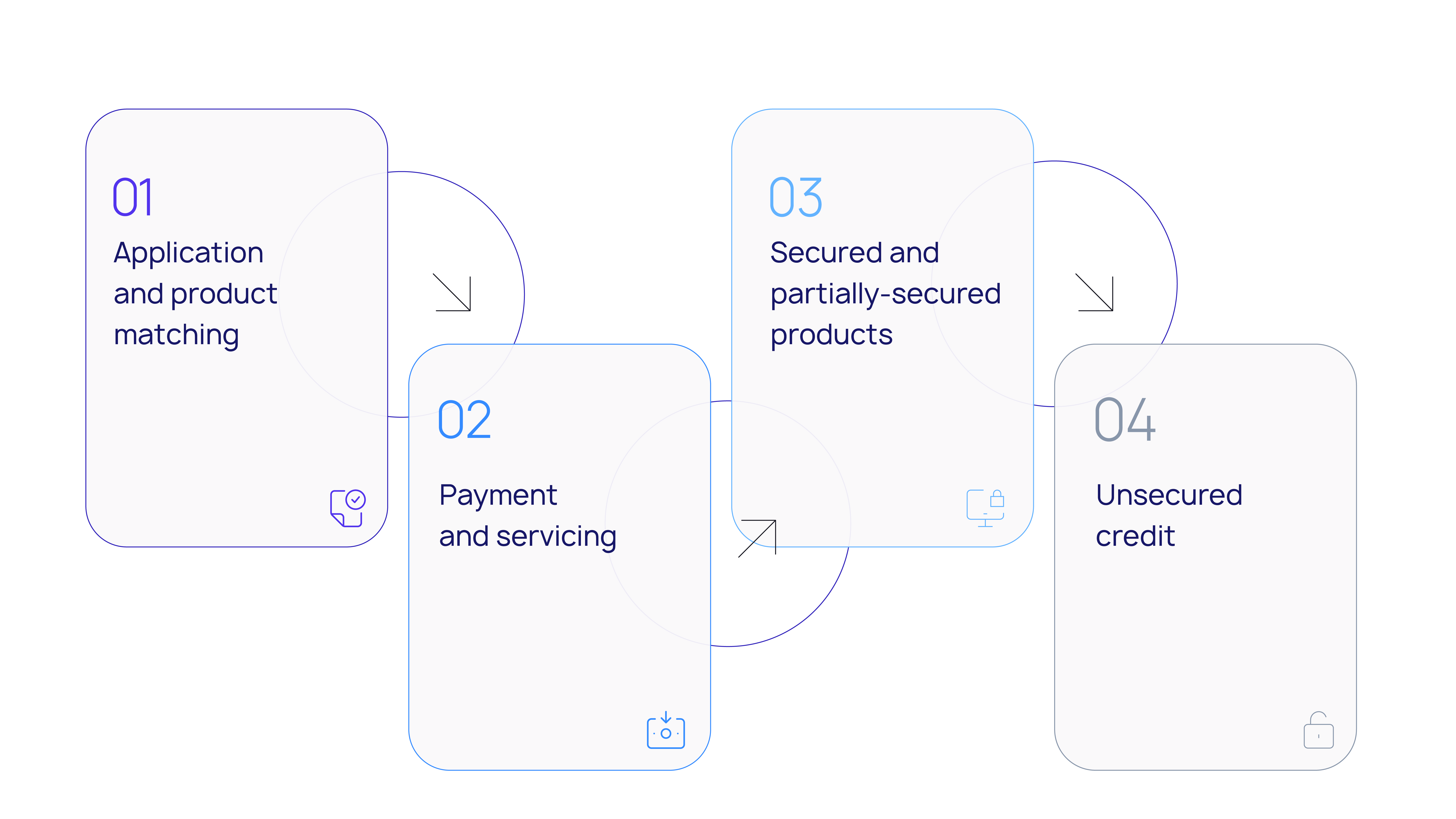To meet Regulation Z requirements, BNPL providers need LoanPro’s modern credit platform
It’s official: BNPL is actually just a credit card.
Well, not exactly, but a recent interpretive rule from the Consumer Financial Protection Bureau (CFPB) says that BNPL and other “digital user accounts” work similarly enough to credit cards that they legally count as cards under Regulation Z, and are subject to all of its rules on issuing and managing card programs.
And although it doesn’t take effect immediately, the 60-day window hasn’t left BNPL providers with a lot of time to rework their card programs and servicing processes to align with Regulation Z.
BNPL lenders need their programs to stay compliant, and that’s best done through LoanPro’s modern credit platform. LoanPro has the tools to seamlessly integrate compliance into your credit products while also driving operational efficiency and enhancing your customer experience. Specifically, we offer solutions to the three major compliance tasks BNPL providers are now faced with:
- Disclosures
- Disputes
- Refunds
Digital user accounts and Regulation Z
If you’re unfamiliar with the interpretive rule, it may be helpful to cover who it applies to and what it changes. The announcement clarified that BNPL falls under the scope of the Truth in Lending Act (TILA), which is implemented as Regulation Z.
First passed back in 1968, TILA is written broadly to anticipate ongoing changes in lending mechanics. Rather than limiting “credit cards” to plastic rectangles, TILA defines them as “any card, plate, coupon book or other credit device existing for the purpose of obtaining money, property, labor, or services on credit”. And according to the new interpretive rule, BNPL is one such “other credit device,” meaning that BNPL providers have to abide by Regulation Z.
More specifically, BNPL now falls under Subpart B, the section governing open-ended credit. Their reasoning for including it here (rather than Subpart C, for instance, which governs installment loans) is that most BNPL programs are set up to encourage repeat business. Rather than treating each BNPL purchase separately, the interpretive rule treats the borrowers’ “digital user account” as the core credit product.
In the interpretive rule, they clarify that while BNPL lenders are now subject to Subpart B of Regulation Z, they’re “generally” not subject to Subpart G (e.g., penalty fee limits and ability-to-repay requirements). While that “generally” doesn’t exactly sound ironclad, it does focus lenders’ attention on Subpart B’s three main requirements: disclosures, disputes, and refunds.
New requirements and LoanPro solutions
Let’s break down the specific requirements that BNPL lenders will now need to comply with, as well as how LoanPro’s modern credit platform addresses them.
Disclosures
| New requirements | LoanPro solutions |
| BNPL providers are now required to disclose information to borrowers at several places in the account lifecycle. As the borrower repays, they’re entitled to periodic statements that inform them of their balance, rate, next payment date, and other account information. These must be delivered at least 21 days before the payment due date. | On legacy systems, lenders might struggle to implement and maintain these new disclosure requirements, as many servicing tasks and lifecycle events now require notifications with specific customer and account information. But with LoanPro’s Communication Suite, lenders can deliver CARD Act compliant disclosures without compromising their operational efficiency. |
| Before the first transaction, they must provide an account opening disclosure explaining if, when, and how a finance charge would apply to the account, including fees or interest rate changes that result from missed payments. They also must include a statement of rights, and mention If the account is securitized. | LoanPro uses our Dynamic Templates to generate statements, contracts, TILA disclosures, and other documents, merging customer and account data with your own branding to create personalized and compliant disclosures. What’s more, LoanPro can fully automate these messages to send when Regulation Z requires, allowing your servicers to focus on more important tasks. |
| Lenders also need to disclose information if the account’s terms change, like a 45-day notice before the interest rate increases and a 30-day notice before a renewal fee is applied. |
Disputes
| New requirements | LoanPro solutions |
| If a borrower notices a problem in a statement, they have sixty days to send a dispute to the lender, who in turn has thirty days to acknowledge the dispute and ninety days to resolve it. Until that dispute is resolved, the lender cannot attempt to collect on the disputed amount, including processing automatic payments. They also must pause credit reporting. | With a real-time database, comprehensive audit trail, and calculations accurate to seven digits past zero, LoanPro cuts down on disputes by minimizing the actual number of billing errors in the first place. |
| The borrower can dispute their statement for any number of reasons: Undelivered statements A payment wasn’t applied The merchant failed to deliver a good or service A request for additional information Other errors in accounting or calculation | When disputes do come in, LoanPro routes them to the right teams so they can be dealt with quickly. Guided step-by-step in Agent Walkthroughs, your servicers can get to the core of the dispute, determine whether there was a legitimate error, correct it, and notify the borrower, all in just a few clicks. And in the meantime, the system will automatically adjust your automated payments, credit reporting, and collections efforts to stay compliant. |
| If the billing error was legitimate, the lender must correct the error and credit the consumer the disputed amount, and notify the borrower of the correction. If the dispute is incorrect, the lender must deliver an explanation, evidence of debt (if requested), and a notice of when the disputed amount will be due. | What’s more, LoanPro’s Automation Engine can identify common problems like failed payments, proactively notifying borrowers and agents before a formal dispute is needed. |
Refunds
| New Requirements | LoanPro solutions |
| One of the problems the CFPB cited was BNPL providers failing to provide a refund if the purchase was returned or the merchant partner never delivered a good or service. (In the case of some solar loans, the solar installer went bankrupt but the customers were left on the hook for payments.) | Refunds aren’t just a legal requirement, but a pivotal moment in your customer experience which could determine whether they use your service again in the future or seek credit elsewhere. That’s why LoanPro’s refunding tools focus on prompt, automatic action that can satisfy the CFPB and your customers alike. |
| Now, BNPL providers must refund borrowers any positive balance greater than a dollar, regardless of whether the balance came from returns, overpayments, merchant failures, rebates or other causes. | Legacy solutions with siloed data will have merchants, borrowers, and lenders disagreeing over whether a good was returned or even delivered in the first place. But through LoanPro’s real-time database and modern API, you can have data synchronized across your platform, your app or customer portal, and the merchants who have integrated with you, each with total visibility into all items connected to the account. |
| After an account balance goes over a dollar positive, the lender has six months to deliver a refund. But if the borrower requests that refund sooner, the lender only has seven business days. | LoanPro’s Automation Engine monitors accounts, detecting when a balance goes positive and promptly triggering the refund process: Our integrated payment processors move the money back into a borrower’s bank account or card, and a notification goes out to the borrower telling them it’s been resolved, all in the same day. |
Migrating and launching on LoanPro
For BNPL providers already using LoanPro, implementing these new compliance measures will be a straightforward transition, seamlessly adding new processes and automations to your existing workflows, ensuring you keep or even enhance your customer experience and operational efficiency as you reduce the risk of compliance problems. What’s more, you’ll have expert help to make sure your BNPL programs and servicing processes align with Regulation Z.
And if these regulatory changes have caught you off guard, don’t panic. Over six hundred lenders have switched to LoanPro, with a typical migration time of just a few months. If your current software is struggling to keep up with an ever-evolving compliance landscape, let’s talk about how LoanPro’s modern credit platform can help you reduce compliance risks and delight your customers.




